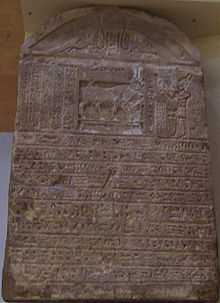Buchis

In Egyptian mythology, Buchis (also spelt Bakh, Buchis, and Bakha) was the manifestation of the deification of Ka (power/life-force) of the war god Montu,[1] worshipped in the region of Hermonthis.
A wild bull was chosen and said to be the Buchis incarnation of Montu, in which role it was worshipped as such. Over time, the criteria for choosing the bull became more rigid, fixing themselves on what had been simply the general appearance of bulls in the region, being a white body and black face.
When these bulls, or their mothers, died, they were mummified, and placed in a special cemetery known as the Bucheum. The mothers of these bulls were considered aspects of Hathor, the mother of these deities.
Eventually, the Bakha was identified as a form of the Apis, and consequently became considered an incarnation of Osiris. The last burial of a Buchis bull in the Bucheum at Hermonthis occurred in 340 A.D.[2][3] The worship of the bull in this form lasted until about 362 AD, when it was destroyed by rising Christianity in the Roman Empire.
See also
- Mnevis
- Apis
- Bull (mythology)
- Hermonthis
References
- ↑ W. Max Muller, Egyptian Mythology, Kessinger Publishing 2004, p.160
- ↑ David Frankfurter, Religion in Roman Egypt: Assimilation and Resistance, Princeton University Press 1998, p.72
- ↑ M. W. Daly, Carl F. Petry, The Cambridge History of Egypt, Cambridge University Press 1998, p.28